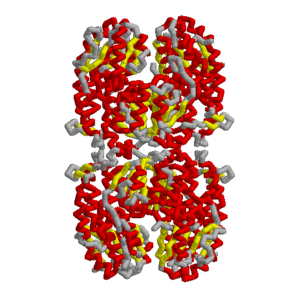User:Gisselle Medina/Sandbox3 Glucosamine 6 Phosphate Synthase
From Proteopedia
Abstract
C. albicans is a fungus normally present on the skin and within the mucous membrane. Despite its common presence, any stimuli for overgrowth can induce the invasion of C. albicans into the throat, intestines, and heart valves as it travels down the bloodstream. The fungus can be present in various morphologies such as rounded buds (yeast), pseudohyphae, and hyphae (mycelia). However, it is the hyphal form that induces the invasion into tissue. Glucose amine 6 phosphate (GlcNAc) synthase is an enzyme that catalyzes the first step in the pathway that ultimately results in hyphal formation. As a result, UDP-GlcNAc, a precursor of chitin, is generated. However, the specific mechanisms for the production of UDP-GlcNAc by this enzyme are not clearly understood. Eukaryotic GlcNAc synthase is a dimer of two dimers and displays a tetrameric structure. Each subunit is composed of two domains, GAH and ISOM. GAH is involved in glutamine hydrolysis while the ISOM domain is directly involved with the isomerization of fructose 6 phosphate to glucose 6 phosphate. We have analyzed and construct a 3D physical model of GlcNAc synthase that focuses on the ISOM domain (346-712 aa) in complex with UDP-GlcNAc and fructose 6 phosphate using the computer software RasMol. In addition, we have selected residues involved in the tetramerization of this enzyme, an intermolecular interaction that is not observed in prokaryotes. Our physical model depicts residues involved in tetramerization (524-527aa, green). Specifically, the carboxylate oxygen atoms of Asp524 interact with hydroxyl group of Ser525 and Ser527. Other contacts between the subunits are present in residues 391-444 (color?). We have also selected fructose 6 phosphate (light green) in complex with the enzyme. Residues of the enzyme that are in close proximity to this molecule; Glu591, Lys588, His607 (light blue) reveal a possible binding region. Finally, UDP-GlcNAc (violet) molecule and surrounding amino acids 474-492 (royal blue) are represented to highlight the binding pocket. Although the distinct tetramerization, fructose interaction sites, and UDP-GlcNAc binding pocket selected in the physical model represent important areas in the development of the invasive mycelia form of C. albicans, there are numerous other factors such as phosphorylation sites present on the GAH domain, amino acids involved in amido transfer, and other regions which are also highly significant. Further investigation could reveal possible competitive inhibition for the binding region of fructose and tetramerization sites which can alter the function of the synthase and thus prevent the formation of UDP-GlcNAc and ultimately inhibiting mycelia transition. As we further explore the structure of the synthase and other molecules in the pathway, we can further elucidate such mechanisms.
Introduction
|
Residues involved in the tetramerization domain. The carboxylate oxygen atoms of interact with hydroxyl group of This enzyme is composed of

